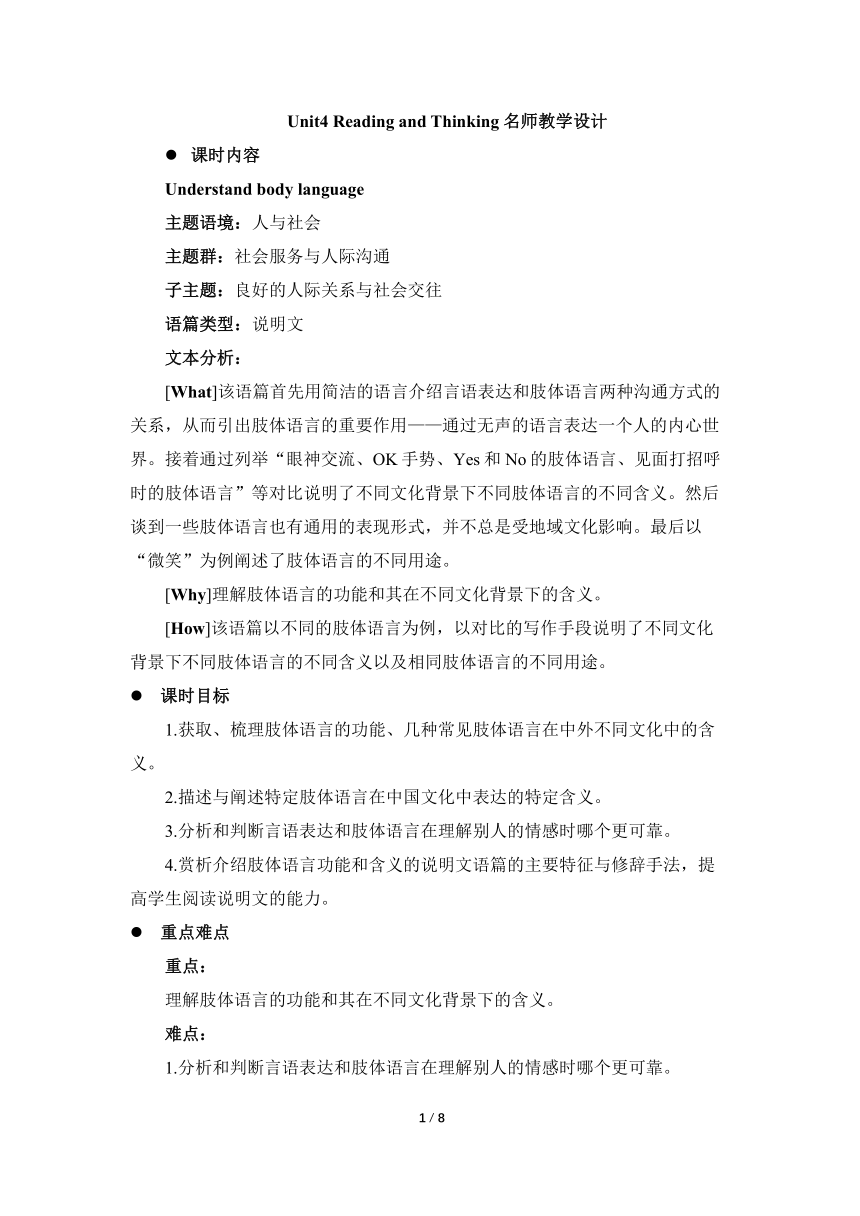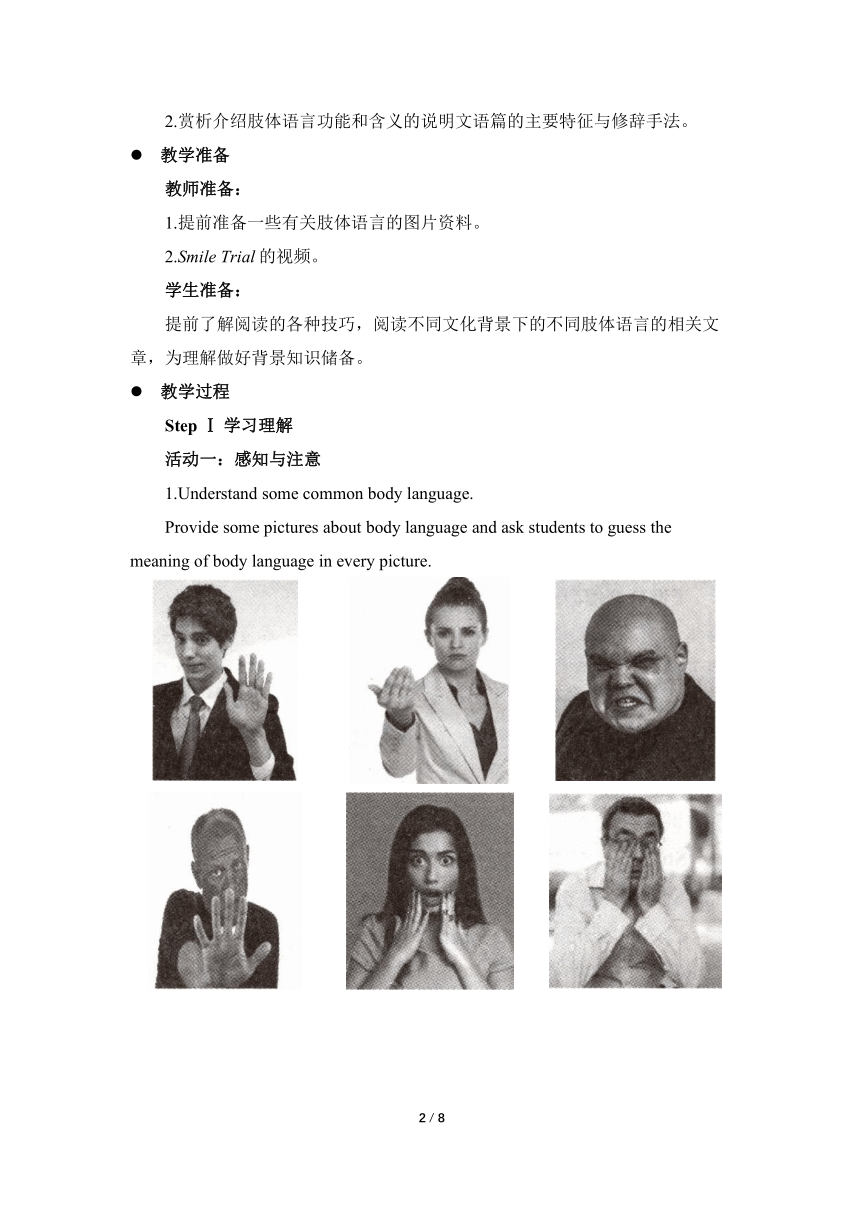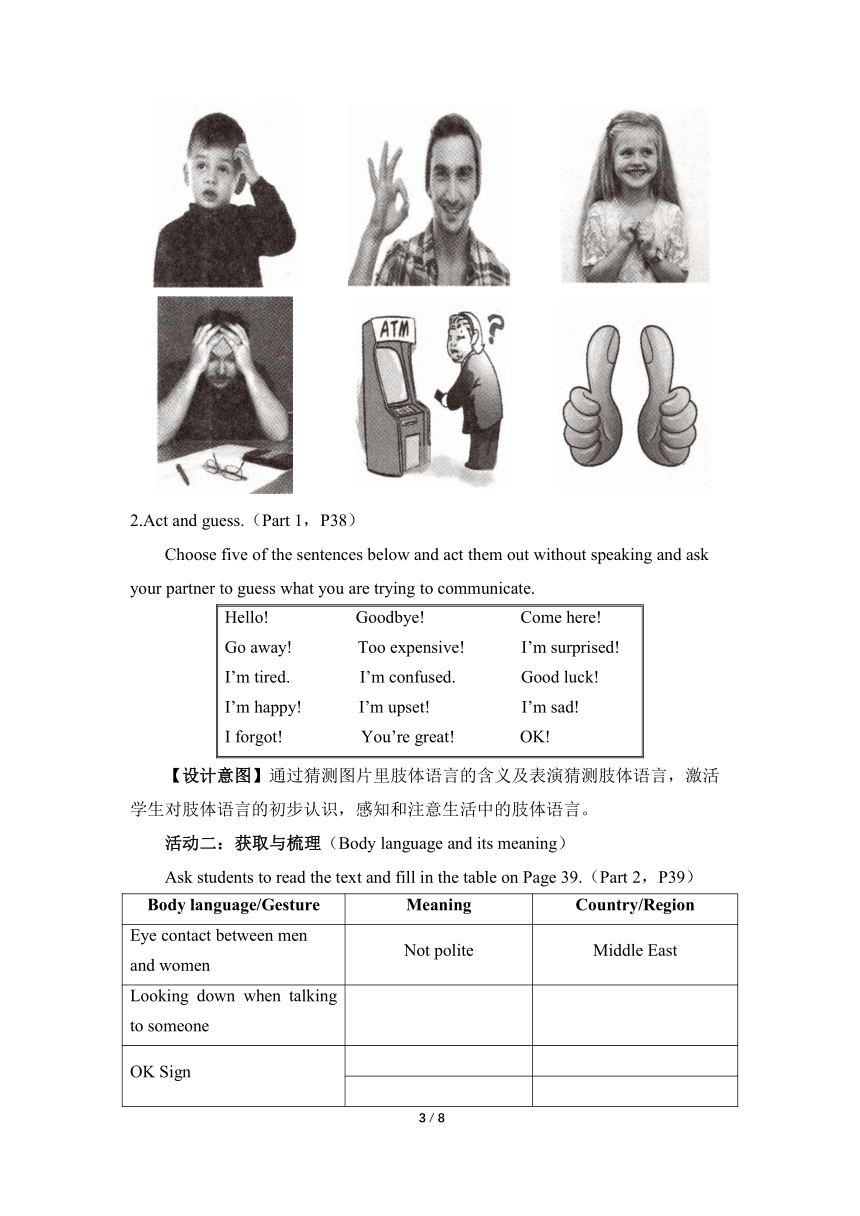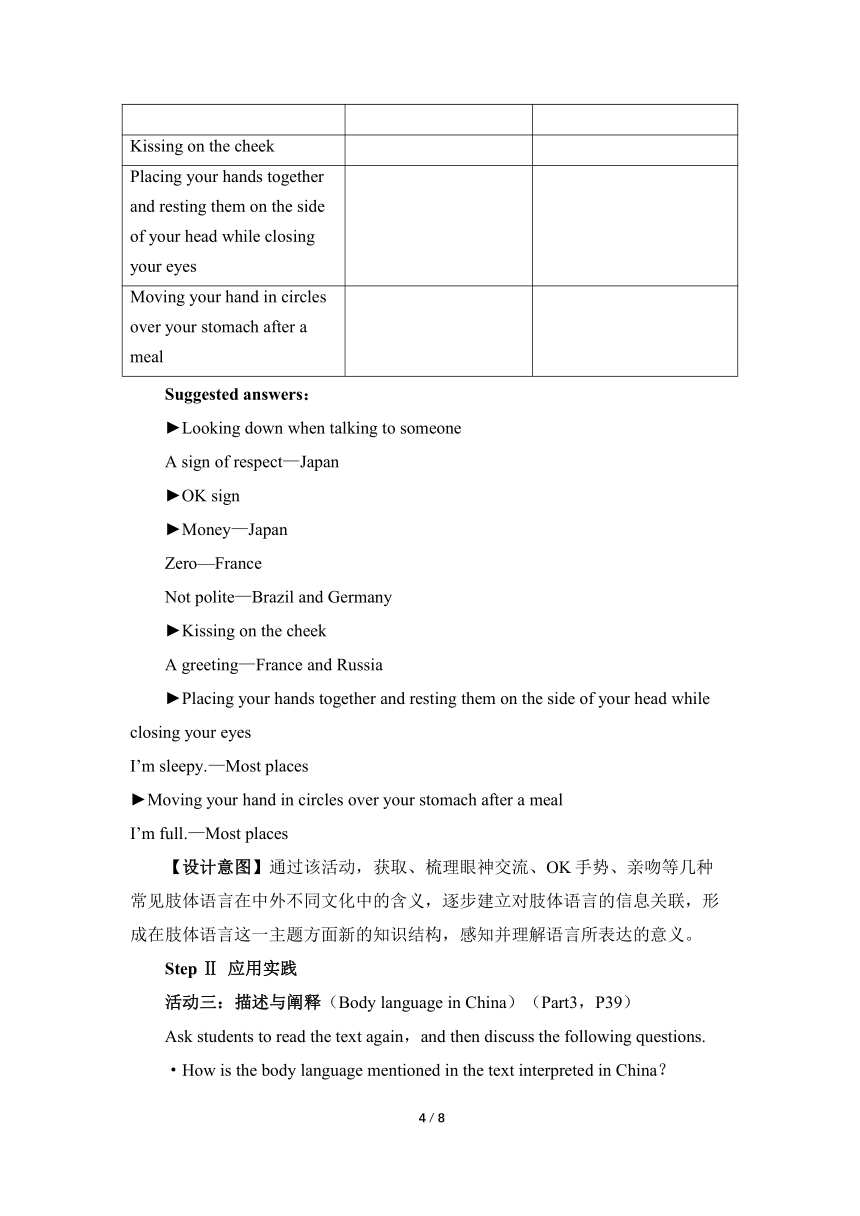人教版(2019)选择性必修 第一册Unit 4 Body Language Reading and Thinking名师教学设计
文档属性
| 名称 | 人教版(2019)选择性必修 第一册Unit 4 Body Language Reading and Thinking名师教学设计 |  | |
| 格式 | docx | ||
| 文件大小 | 1.3MB | ||
| 资源类型 | 教案 | ||
| 版本资源 | 人教版(2019) | ||
| 科目 | 英语 | ||
| 更新时间 | 2023-03-11 20:46:26 | ||
图片预览




文档简介
Unit4 Reading and Thinking 名师教学设计
课时内容
Understand body language
主题语境:人与社会
主题群:社会服务与人际沟通
子主题:良好的人际关系与社会交往
语篇类型:说明文
文本分析:
[What]该语篇首先用简洁的语言介绍言语表达和肢体语言两种沟通方式的关系,从而引出肢体语言的重要作用——通过无声的语言表达一个人的内心世界。接着通过列举“眼神交流、OK手势、Yes和No的肢体语言、见面打招呼时的肢体语言”等对比说明了不同文化背景下不同肢体语言的不同含义。然后谈到一些肢体语言也有通用的表现形式,并不总是受地域文化影响。最后以“微笑”为例阐述了肢体语言的不同用途。
[Why]理解肢体语言的功能和其在不同文化背景下的含义。
[How]该语篇以不同的肢体语言为例,以对比的写作手段说明了不同文化背景下不同肢体语言的不同含义以及相同肢体语言的不同用途。
课时目标
1.获取、梳理肢体语言的功能、几种常见肢体语言在中外不同文化中的含义。
2.描述与阐述特定肢体语言在中国文化中表达的特定含义。
3.分析和判断言语表达和肢体语言在理解别人的情感时哪个更可靠。
4.赏析介绍肢体语言功能和含义的说明文语篇的主要特征与修辞手法,提高学生阅读说明文的能力。
重点难点
重点:
理解肢体语言的功能和其在不同文化背景下的含义。
难点:
1.分析和判断言语表达和肢体语言在理解别人的情感时哪个更可靠。
2.赏析介绍肢体语言功能和含义的说明文语篇的主要特征与修辞手法。
教学准备
教师准备:
1.提前准备一些有关肢体语言的图片资料。
2.Smile Trial的视频。
学生准备:
提前了解阅读的各种技巧,阅读不同文化背景下的不同肢体语言的相关文章,为理解做好背景知识储备。
教学过程
Step Ⅰ 学习理解
活动一:感知与注意
1.Understand some common body language.
Provide some pictures about body language and ask students to guess the meaning of body language in every picture.
2.Act and guess.(Part 1,P38)
Choose five of the sentences below and act them out without speaking and ask your partner to guess what you are trying to communicate.
Hello! Goodbye! Come here! Go away! Too expensive! I’m surprised! I’m tired. I’m confused. Good luck! I’m happy! I’m upset! I’m sad! I forgot! You’re great! OK!
【设计意图】通过猜测图片里肢体语言的含义及表演猜测肢体语言,激活学生对肢体语言的初步认识,感知和注意生活中的肢体语言。
活动二:获取与梳理(Body language and its meaning)
Ask students to read the text and fill in the table on Page 39.(Part 2,P39)
Body language/Gesture Meaning Country/Region
Eye contact between men and women Not polite Middle East
Looking down when talking to someone
OK Sign
Kissing on the cheek
Placing your hands together and resting them on the side of your head while closing your eyes
Moving your hand in circles over your stomach after a meal
Suggested answers:
Looking down when talking to someone
A sign of respect—Japan
OK sign
Money—Japan
Zero—France
Not polite—Brazil and Germany
Kissing on the cheek
A greeting—France and Russia
Placing your hands together and resting them on the side of your head while closing your eyes
I’m sleepy.—Most places
Moving your hand in circles over your stomach after a meal
I’m full.—Most places
【设计意图】通过该活动,获取、梳理眼神交流、OK手势、亲吻等几种常见肢体语言在中外不同文化中的含义,逐步建立对肢体语言的信息关联,形成在肢体语言这一主题方面新的知识结构,感知并理解语言所表达的意义。
Step Ⅱ 应用实践
活动三:描述与阐释(Body language in China)(Part3,P39)
Ask students to read the text again,and then discuss the following questions.
·How is the body language mentioned in the text interpreted in China?
·Can you think of an example of body language that is appropriate in China but might be misunderstood in another culture?
·What advice on body language can you give a foreign friend on his/her first trip to China?
Suggested answers:
·Some are the same in China. For example,the gesture for putting hands together and resting them on the side of your head means sleeping.
·Avoiding eye contact and lowering one’s head may mean respect and being shy in China,whereas in some other countries this body language may be interpreted as being rude.
·Please pay attention to the social distance,which is different in China and in the West.
【设计意图】通过该活动,描述与阐述特定肢体语言在中国文化中表达的特定含义,加深对肢体语言的理解,提高对肢体语言文化差异的敏感度和处理肢体语言文化差异的灵活性,提高学生跨文化交际和沟通的能力。
活动四:分析与判断(Body language or spoken language)(Part 4,P39)
1.Fake smiles.
Ask students to discuss the question and understand some fake smiles.
Smiles can be used to hide feelings like anger,fear,or worry. Can you describe a situation where you might smile when you don’t mean it?
2.Fake body language.
Ask students to give some other kind of body language that can sometimes be fake apart from fake smiles.
3.Body language or spoken language.
Ask students to discuss:Which is a more reliable guide for understanding someone’s feelings,their body language or the words they speak?
Suggested answers:
1.Sometimes I smile when I am impatient,but I know I shouldn’t be. For example,if I am riding a train and a baby starts crying,I may try to smile,because even though the baby’s crying is annoying,I know that it is not the baby’s fault and there is probably nothing that can be done.
2.There are “crocodile tears”,This is when a person fakes feeling sad or sympathetic for another person.(The phrase comes from an old story that crocodiles cry while they are eating,as though they feel sad for their victim.)
3.Their body language is much more reliable than the words they say,because most people have trouble hiding their anger,disappointment,or irritation.
【设计意图】通过讨论微笑有时候可以用来隐藏生气、恐惧或担心等情绪的问题,学生描述自己类似的亲身经历和其他使用非本意的肢体语言的情况,能够理解到肢体语言有时候并不表达本意,接着分析和判断言语表达和肢体语言在理解别人的情感时哪个更可靠,加深对肢体语言的主题意义的认识,逐步实现对语言知识和文化知识的内化,巩固新的知识结构,促进语言运用的自动化,助力学生将知识转化为能力。
Step Ⅲ 迁移创新
活动五:赏析语篇的文体特征(Critical thinking)
1.Ask students to circle the answers to the questions below.
(1)Where would you most likely find the passage?
A. In a book.
B. In an advertisement.
C. In a letter.
D. In a newspaper.
(2)Which of the writing methods is employed?
A. Illustration.(举例法)
B. Classification.(分类法)
C. Giving figures.(列数字)
D. Contrast.(作对比)
Suggested answers:
(1)A (2)AD
2.Ask students to discuss the questions and then share the answers.
·What is the purpose of the text?
·Who is the intended audience of this text?
·Which part of the passage impresses you most?Why?
·Which paragraph or sentence do you like best?Give your reasons?
·How do you like the title of the passage?Why?Can you make a new one?
·How do you like the picture of the passage?Can you add some more pictures to the passage and make the passage better understood.
Suggested answers:
·It introduces different body language and its meaning.
·The intended audience may be anyone who is interested t in body language in different countries.
·(以下略)
【设计意图】英语事物说明文具有独特的语篇结构和文体特征,对他们从文本写作方法、文章结构、写作目的、读者对象、文本句子写作、文本内容、文章插图等方面进行分析和研究,可以帮助学生提高对英语说明文的理解和欣赏能力,也有助于提高学生在英语说明文方面的写作能力、多元思维能力。
活动六:想象与创造(Creative thinking)
Ask students to work in groups of six and make a real play.
(1)Each one will choose a role from China,Japan,Brazil,Germany,France or Russia.
(2)They meet and communicate with body language.
(3)Share their feelings about misunderstanding and embarrassment.
【设计意图】该活动与学生生活相关联,让学生利用在文本中所学的肢体语言在真实生活中进行交流,体会肢体语言的魅力与误用肢体语言带来的尴尬,实现读有所用,利用别人的思想改变自己的行为。
板书设计
Unit 4 Body Language Period Ⅰ Reading and Thinking Ⅰ.学习理解 活动一:感知与注意 1.Understand some common body language. 2.Act and guess. Ⅱ.应用实践 活动三:描述与阐释(Body language in China) 活动四:分析与判断(Body language or spoken language) Ⅲ.迁移创新 活动五:赏析语篇的文体特征(Critical thinking) 活动六:想象与创造(Creative thinking)
2 / 2
课时内容
Understand body language
主题语境:人与社会
主题群:社会服务与人际沟通
子主题:良好的人际关系与社会交往
语篇类型:说明文
文本分析:
[What]该语篇首先用简洁的语言介绍言语表达和肢体语言两种沟通方式的关系,从而引出肢体语言的重要作用——通过无声的语言表达一个人的内心世界。接着通过列举“眼神交流、OK手势、Yes和No的肢体语言、见面打招呼时的肢体语言”等对比说明了不同文化背景下不同肢体语言的不同含义。然后谈到一些肢体语言也有通用的表现形式,并不总是受地域文化影响。最后以“微笑”为例阐述了肢体语言的不同用途。
[Why]理解肢体语言的功能和其在不同文化背景下的含义。
[How]该语篇以不同的肢体语言为例,以对比的写作手段说明了不同文化背景下不同肢体语言的不同含义以及相同肢体语言的不同用途。
课时目标
1.获取、梳理肢体语言的功能、几种常见肢体语言在中外不同文化中的含义。
2.描述与阐述特定肢体语言在中国文化中表达的特定含义。
3.分析和判断言语表达和肢体语言在理解别人的情感时哪个更可靠。
4.赏析介绍肢体语言功能和含义的说明文语篇的主要特征与修辞手法,提高学生阅读说明文的能力。
重点难点
重点:
理解肢体语言的功能和其在不同文化背景下的含义。
难点:
1.分析和判断言语表达和肢体语言在理解别人的情感时哪个更可靠。
2.赏析介绍肢体语言功能和含义的说明文语篇的主要特征与修辞手法。
教学准备
教师准备:
1.提前准备一些有关肢体语言的图片资料。
2.Smile Trial的视频。
学生准备:
提前了解阅读的各种技巧,阅读不同文化背景下的不同肢体语言的相关文章,为理解做好背景知识储备。
教学过程
Step Ⅰ 学习理解
活动一:感知与注意
1.Understand some common body language.
Provide some pictures about body language and ask students to guess the meaning of body language in every picture.
2.Act and guess.(Part 1,P38)
Choose five of the sentences below and act them out without speaking and ask your partner to guess what you are trying to communicate.
Hello! Goodbye! Come here! Go away! Too expensive! I’m surprised! I’m tired. I’m confused. Good luck! I’m happy! I’m upset! I’m sad! I forgot! You’re great! OK!
【设计意图】通过猜测图片里肢体语言的含义及表演猜测肢体语言,激活学生对肢体语言的初步认识,感知和注意生活中的肢体语言。
活动二:获取与梳理(Body language and its meaning)
Ask students to read the text and fill in the table on Page 39.(Part 2,P39)
Body language/Gesture Meaning Country/Region
Eye contact between men and women Not polite Middle East
Looking down when talking to someone
OK Sign
Kissing on the cheek
Placing your hands together and resting them on the side of your head while closing your eyes
Moving your hand in circles over your stomach after a meal
Suggested answers:
Looking down when talking to someone
A sign of respect—Japan
OK sign
Money—Japan
Zero—France
Not polite—Brazil and Germany
Kissing on the cheek
A greeting—France and Russia
Placing your hands together and resting them on the side of your head while closing your eyes
I’m sleepy.—Most places
Moving your hand in circles over your stomach after a meal
I’m full.—Most places
【设计意图】通过该活动,获取、梳理眼神交流、OK手势、亲吻等几种常见肢体语言在中外不同文化中的含义,逐步建立对肢体语言的信息关联,形成在肢体语言这一主题方面新的知识结构,感知并理解语言所表达的意义。
Step Ⅱ 应用实践
活动三:描述与阐释(Body language in China)(Part3,P39)
Ask students to read the text again,and then discuss the following questions.
·How is the body language mentioned in the text interpreted in China?
·Can you think of an example of body language that is appropriate in China but might be misunderstood in another culture?
·What advice on body language can you give a foreign friend on his/her first trip to China?
Suggested answers:
·Some are the same in China. For example,the gesture for putting hands together and resting them on the side of your head means sleeping.
·Avoiding eye contact and lowering one’s head may mean respect and being shy in China,whereas in some other countries this body language may be interpreted as being rude.
·Please pay attention to the social distance,which is different in China and in the West.
【设计意图】通过该活动,描述与阐述特定肢体语言在中国文化中表达的特定含义,加深对肢体语言的理解,提高对肢体语言文化差异的敏感度和处理肢体语言文化差异的灵活性,提高学生跨文化交际和沟通的能力。
活动四:分析与判断(Body language or spoken language)(Part 4,P39)
1.Fake smiles.
Ask students to discuss the question and understand some fake smiles.
Smiles can be used to hide feelings like anger,fear,or worry. Can you describe a situation where you might smile when you don’t mean it?
2.Fake body language.
Ask students to give some other kind of body language that can sometimes be fake apart from fake smiles.
3.Body language or spoken language.
Ask students to discuss:Which is a more reliable guide for understanding someone’s feelings,their body language or the words they speak?
Suggested answers:
1.Sometimes I smile when I am impatient,but I know I shouldn’t be. For example,if I am riding a train and a baby starts crying,I may try to smile,because even though the baby’s crying is annoying,I know that it is not the baby’s fault and there is probably nothing that can be done.
2.There are “crocodile tears”,This is when a person fakes feeling sad or sympathetic for another person.(The phrase comes from an old story that crocodiles cry while they are eating,as though they feel sad for their victim.)
3.Their body language is much more reliable than the words they say,because most people have trouble hiding their anger,disappointment,or irritation.
【设计意图】通过讨论微笑有时候可以用来隐藏生气、恐惧或担心等情绪的问题,学生描述自己类似的亲身经历和其他使用非本意的肢体语言的情况,能够理解到肢体语言有时候并不表达本意,接着分析和判断言语表达和肢体语言在理解别人的情感时哪个更可靠,加深对肢体语言的主题意义的认识,逐步实现对语言知识和文化知识的内化,巩固新的知识结构,促进语言运用的自动化,助力学生将知识转化为能力。
Step Ⅲ 迁移创新
活动五:赏析语篇的文体特征(Critical thinking)
1.Ask students to circle the answers to the questions below.
(1)Where would you most likely find the passage?
A. In a book.
B. In an advertisement.
C. In a letter.
D. In a newspaper.
(2)Which of the writing methods is employed?
A. Illustration.(举例法)
B. Classification.(分类法)
C. Giving figures.(列数字)
D. Contrast.(作对比)
Suggested answers:
(1)A (2)AD
2.Ask students to discuss the questions and then share the answers.
·What is the purpose of the text?
·Who is the intended audience of this text?
·Which part of the passage impresses you most?Why?
·Which paragraph or sentence do you like best?Give your reasons?
·How do you like the title of the passage?Why?Can you make a new one?
·How do you like the picture of the passage?Can you add some more pictures to the passage and make the passage better understood.
Suggested answers:
·It introduces different body language and its meaning.
·The intended audience may be anyone who is interested t in body language in different countries.
·(以下略)
【设计意图】英语事物说明文具有独特的语篇结构和文体特征,对他们从文本写作方法、文章结构、写作目的、读者对象、文本句子写作、文本内容、文章插图等方面进行分析和研究,可以帮助学生提高对英语说明文的理解和欣赏能力,也有助于提高学生在英语说明文方面的写作能力、多元思维能力。
活动六:想象与创造(Creative thinking)
Ask students to work in groups of six and make a real play.
(1)Each one will choose a role from China,Japan,Brazil,Germany,France or Russia.
(2)They meet and communicate with body language.
(3)Share their feelings about misunderstanding and embarrassment.
【设计意图】该活动与学生生活相关联,让学生利用在文本中所学的肢体语言在真实生活中进行交流,体会肢体语言的魅力与误用肢体语言带来的尴尬,实现读有所用,利用别人的思想改变自己的行为。
板书设计
Unit 4 Body Language Period Ⅰ Reading and Thinking Ⅰ.学习理解 活动一:感知与注意 1.Understand some common body language. 2.Act and guess. Ⅱ.应用实践 活动三:描述与阐释(Body language in China) 活动四:分析与判断(Body language or spoken language) Ⅲ.迁移创新 活动五:赏析语篇的文体特征(Critical thinking) 活动六:想象与创造(Creative thinking)
2 / 2
